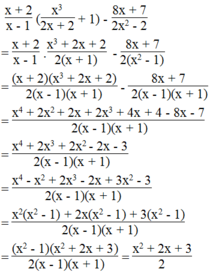Hãy nhập câu hỏi của bạn vào đây, nếu là tài khoản VIP, bạn sẽ được ưu tiên trả lời.

\(a,A=\dfrac{1}{x-2}+\dfrac{1}{x+2}+\dfrac{x^2+1}{x^2-4}\left(dkxd:x\ne\pm2\right)\)
\(=\dfrac{x+2+x-2+x^2+1}{\left(x-2\right)\left(x+2\right)}\)
\(=\dfrac{x^2+2x+1}{\left(x-2\right)\left(x+2\right)}\)
\(=\dfrac{\left(x+1\right)^2}{x^2-4}\)
Vậy \(A=\dfrac{\left(x+1\right)^2}{x^2-4}\)
\(b,\) Theo đề, ta có : \(-2< x< 2\)
\(\Rightarrow x-2< 0;x+2>0;\left(x+1\right)^2>0\)
\(\Rightarrow A< 0\) hay phân thức luôn có giá trị âm

Điều kiện x ≠ 1 và x ≠ - 1
Ta có:

Biểu thức dương khi x 2 + 2 x + 3 > 0
Ta có: x 2 + 2 x + 3 = x 2 + 2 x + 1 + 2 = x + 1 2 + 2 > 0 với mọi giá trị của x.
Vậy giá trị của biểu thức dương với mọi giá trị x ≠ 1 và x ≠ - 1

a) \(A=\left(2x+1\right)^2-\left(x+2\right)\left(x-2\right)-2x\left(x+1\right)\)
\(A=4x^2+4x+1-x^2+4-2x^2-2x\)
\(A=x^2+2x+5\)
b) Để A = 4
=> \(x^2+2x+5=4\)
\(\Leftrightarrow x^2+2x+1=0\)
\(\Leftrightarrow\left(x+1\right)^2=0\)
\(\Leftrightarrow x+1=0\Leftrightarrow x=-1\)
c) Ta có A = x2 + 2x + 5
A = ( x + 1 )2 + 4
=> \(A\ge4>0\left(đpcm\right)\)
a,\(A=\left(2x+1\right)^2-\left(x+2\right)\left(x-2\right)-2x\left(x+1\right)\)
\(=4x^2+4x+1-x^2+4-2x^2-2x\)
\(=x^2+2x+5\)
b,\(A=x^2+2x+5=4\)
\(\Rightarrow x^2+2x+5-4=0\)
\(x^2+2x+1=0\)
\(\left(x+1\right)^2=0\)
\(x+1=0\)
\(x=-1\)
c, Ta có: \(A=x^2+2x+5=\left(x^2+2x+1\right)+4=\left(x+1\right)^2+4\ge4>0\)
Hay: A > 0 => đpcm
=.= hok tốt!!

a)ĐKXĐ:\(\begin{cases}x\ge0\\2\sqrt{x}-2\ne0\\1-x\ne0\\\end{cases}\)
`<=>` \(\begin{cases}x\ge0\\x\ne1\\\end{cases}\)
`B=1/(2sqrtx-2)-1/(2sqrtx+2)+sqrtx/(1-x)`
`=1/(2(sqrtx-1))-1/(2(sqrtx+1))-sqrtx/(x-1)`
`=(sqrtx+1-(sqrtx-1)-2sqrtx)/(2(sqrtx-1)(sqrtx+1))`
`=(2-2sqrtx)/(2(sqrtx-1)(sqrtx+1))`
`=(2(1-sqrtx))/(2(sqrtx-1)(sqrtx+1))`
`=-1/(sqrtx+1)`
`b)x=3`
`=>B=(-1)/(sqrt3+1)`
`=(-(sqrt3-1))/(3-1)`
`=(1-sqrt3)/2`
`c)|A|=1/2`
`<=>|(-1)/(sqrtx+1)|=1/2`
`<=>|1/(sqrtx+1)|=1/2`
`<=>1/(sqrtx+1)=1/2` do `1>0,sqrtx+1>=1>0`
`<=>sqrtx+1=2`
`<=>sqrtx=1`
`<=>x=1` loại vì `x ne 1`.
a) ĐKXĐ: \(\left\{{}\begin{matrix}x\ge0\\x\ne1\end{matrix}\right.\)
Ta có: \(B=\dfrac{1}{2\sqrt{x}-2}-\dfrac{1}{2\sqrt{x}+2}+\dfrac{\sqrt{x}}{1-x}\)
\(=\dfrac{\sqrt{x}+1-\sqrt{x}+1-2\sqrt{x}}{2\left(\sqrt{x}-1\right)\left(\sqrt{x}+1\right)}\)
\(=\dfrac{-2\left(\sqrt{x}-1\right)}{2\left(\sqrt{x}-1\right)\left(\sqrt{x}+1\right)}\)
\(=\dfrac{-1}{\sqrt{x}+1}\)
b) Thay x=3 vào B, ta được:
\(B=\dfrac{-1}{\sqrt{3}+1}=\dfrac{-\sqrt{3}+1}{2}\)
c) Ta có: \(\left|A\right|=\dfrac{1}{2}\)
nên \(\left[{}\begin{matrix}A=\dfrac{1}{2}\\A=-\dfrac{1}{2}\end{matrix}\right.\Leftrightarrow\left[{}\begin{matrix}\dfrac{-1}{\sqrt{x}+1}=\dfrac{1}{2}\\\dfrac{-1}{\sqrt{x}+1}=\dfrac{-1}{2}\end{matrix}\right.\)
\(\Leftrightarrow\left[{}\begin{matrix}\sqrt{x}+1=-2\\\sqrt{x}+1=2\end{matrix}\right.\Leftrightarrow x=1\)(loại)
ĐKXĐ: \(x\notin\left\{1;-1\right\}\)
a) Ta có: \(C=\left(x^2-1\right)\cdot\left(\dfrac{1}{x-1}-\dfrac{1}{x+1}+1\right)\)
\(=\left(x^2-1\right)\cdot\left(\dfrac{x+1}{\left(x-1\right)\left(x+1\right)}-\dfrac{x-1}{\left(x+1\right)\left(x-1\right)}+\dfrac{x^2-1}{\left(x-1\right)\left(x+1\right)}\right)\)
\(=\left(x^2-1\right)\cdot\dfrac{x+1-x+1+x^2-1}{\left(x+1\right)\left(x-1\right)}\)
\(=x^2-1\)